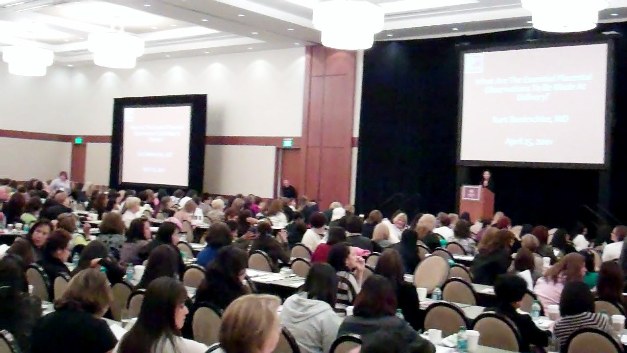
Dr. Manuel Porto has taken up the cause of pre-term birth prevention for 28 years.
The lead message from Pomona Valley Hospital Medical Center’s (PVHMC) 22nd Annual Perinatal Symposium at the Fairplex Convention Center on Wednesday, April 18, came through loud and clear: “Babies Are Worth the Wait.”
“The vast difference in newborn development between a 39-40 week gestation infant and one born just a few weeks earlier can be critical to the baby’s immediate and longer-term health and well-being,” said Dr. Hellen Rodriguez, PVHMC medical director of Maternal-Fetal Medicine.
Indeed, pre-term birth – birth before 37 weeks completed gestation – is a serious health problem that costs the United States more than $26 billion annually, according to the Institute of Medicine. Babies born just a few weeks early have higher rates of hospitalization and illness than full-term infants.
Dr. Manuel Porto, professor and chairman of the Department of Obstetrics and Gynecology at UC Irvine who kicked off the all-day symposium, was far more explicit in describing the devastating impact premature births have on society, and families, in particular.
“It has long-term consequences on our future citizens — our newborn babies that have cerebral palsy, developmental delay, chronic lung disease, deafness, blindness, said Porto, who has been studying newborns for 28 years. “A lot of these problems are attributable to being born too soon.”
In his PowerPoint presentation before more than 700 nurses and other medical professionals, Dr. Porto revealed that a baby’s brain at 35 weeks weighs only two-thirds of what it will weigh at 39 to 40 weeks.
Many of these premature babies also are more likely to face sucking, swallowing and breathing problems than full-term babies, as well as breathing problems like apnea (when the baby stops breathing). Babies born early are also more likely to die of sudden infant death syndrome (SIDS).
Dr. Rodriguez noted that many consequences of pre-term births often don’t manifest themselves for five to 10 years.
“They don’t do nearly as well as their counterparts who are delivered after 39 weeks, she said. “You’re 38-weeker, that’s the child that will have to be held back in kindergarten, that’s the child who is the disruptive child in first grade.”
Dr. Porto admitted that despite steady advances in scientific knowledge and technology, the medical community still doesn’t know what triggers the physiological mechanism of normal labor, as well as labors that happen too soon.
“We know very well how it happens in sheep, rhesus monkeys, rats and rabbits, but as it turns out, unfortunately, their system and approach are very different from human beings, so we don’t have anyone to practice on in the laboratory.
“We have only bits and pieces of the puzzle.”
But those bits and pieces — along with involvement from the March of Dimes, the American Congress of Obstetricians and Gynecologists and other national health organizations — have given Porto and other health care providers, enough objective, evidence-based data to develop a Preterm Labor Assessment Toolkit that can reduce the number of premature births.

Attendees were in the hundreds, all on board to better learn how to reduce the number of pre-term births.
In the tool bag are two tests: the transvaginal ultrasound or TVU and the Fetal Fibronectin (fFN), a chemical test administered with a cervical swab. If both tests return positive, there is a far greater possibility of imminent delivery, and the physician can start an intervention strategy to better manage the pregnancy, including corticosteroids and progesterone therapies for preterm babies, 34 weeks or less, to stimulate lung growth and reduce bleeding into the brain. About 12 percent of women deliver premature babies.
The TVU and fFN tests also are good indicators for ruling out pre-term labor. “Uterine contractions alone are a poor positive predictor of true preterm labor, Dr. Porto said, adding that 50 percent to 80 percent of women admitted to the hospital for preterm labor are discharged and ultimately delivered at term.
Being sent home by the doctor, when there are no medical signs indicating imminent delivery, is really the best news a mother can receive.
“It shouldn’t be seen as a disappointment,” said Vicki Lombardo, a registered nurse and associate state director of Program Services for the March of Dimes. “It’s an okay thing, those contractions are like the uterus going to the gym. It’s just getting ready, it’s not in labor.”
Keeping women who have false labor out of the hospital reduces not only medical costs, but also health risks to mother and child. With more accurate information, doctors are less likely to prescribe unnecessary medicines (which could complicate other medical conditions) or even bed rest.
“Women who are sitting in bed have a much higher risk of developing thrombosis in their legs, which can lead to pulmonary embolism,” Porto said, further noting “there’s no great evidence that bed rest prevents anyone from delivering prematurely.”
Although UCI and PVHMC, which welcomes about 7,000 full-term and pre-term births a year, are “tertiary centers” capable of providing the highest level of neonatal care possible, both doctors Porto, Rodriguez and their teams strongly advocate strong pre-conception planning by parents to ensure more successful pregnancy outcomes.
“We spend more money than any other industrialized country in the world,” Dr. Rodriguez said, “but we rank 34 out of 37 in terms of preventing pre-term births.”
While many potential factors (greater use of assisted reproductive technology resulting in multiple pregnancies, short maternity leaves, stress, etc.) have been suggested, obesity seems to be a clear cause of premature babies.
“Get yourself in shape before you get pregnant,” Dr Rodriguez said. “Women used to think you had to put on 30 or 35 pounds, but if you’re starting at 200 pounds, you don’t need to put on 30 or 35 pounds. You can minimize it to 12 to 15 pounds.
“You really don’t need to eat for two.”
With less weight gain, mothers will put themselves at less risk for diabetes, toxemia, hypertension, cesarean section and other medical conditions, she added.
With less weight gain, mothers also will be in better shape physically and mentally to cope with the recommended 39 to 41 weeks of a full-term pregnancy and less apt to pressure their doctor to schedule an early delivery date to relieve their back pain, swelling and other pregnancy-related discomfort, ranging from pelvic pain to stretch marks.
Unless the health of the mother or the baby is at risk, there is no good reason to schedule an early birth, despite the medical miracles neonatal units routinely perform.
“Even if you’re going to get a higher income tax deduction or your mother can only be in town a certain week, or you want your baby born on your great grandmother’s birthday, those are not good reasons to have your baby early because your baby needs those extra weeks and days,” Lombardo said.
At the end of the day, doctors Porto and Rodriguez and their fellow conference organizers wanted audience members to remember just one number: 39.
“The bottom line,” Porto said, “is patients talk in months, but we in the business only talk about weeks.”
“Thirty-nine weeks,” Lombardo added, “gives babies all the time they need to grow before they’re born. Births scheduled before 39 weeks should only be for medical reasons.”



Leave a Reply